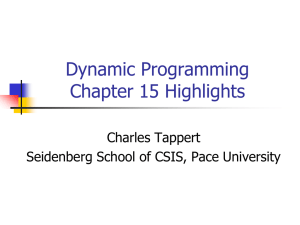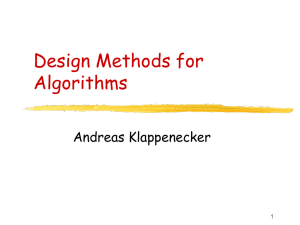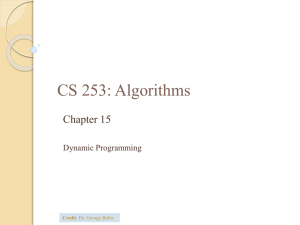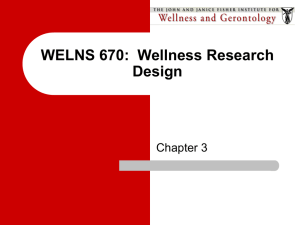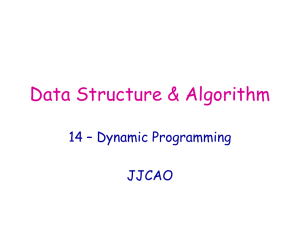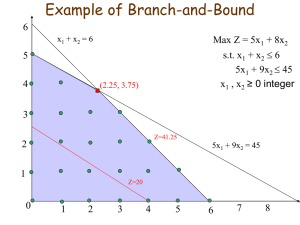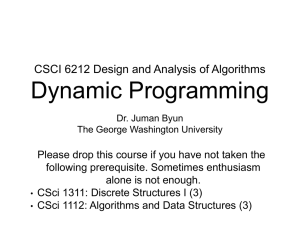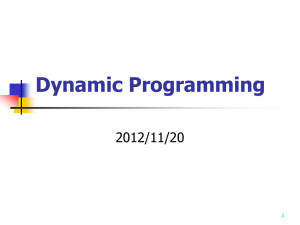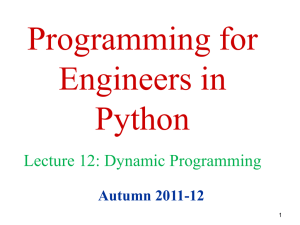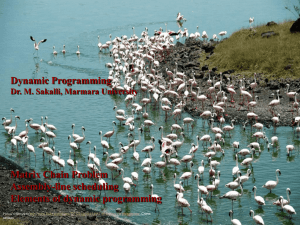Dynamic Programming
advertisement
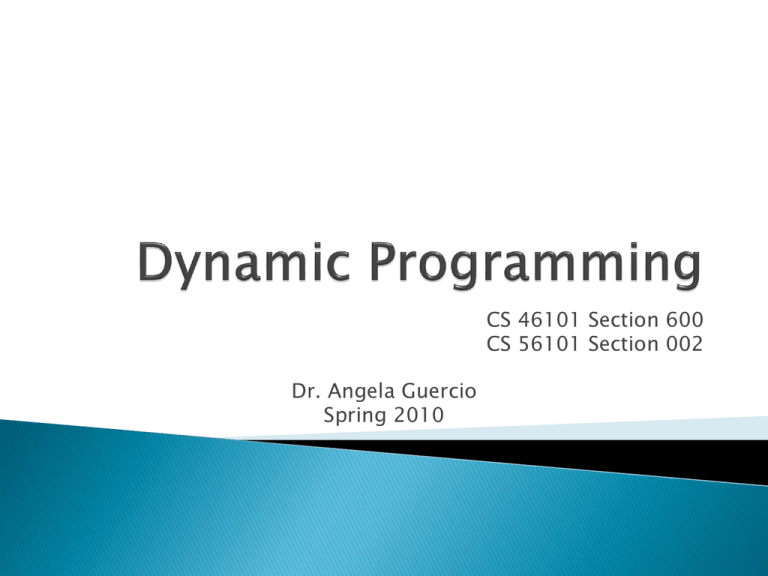
CS 46101 Section 600 CS 56101 Section 002 Dr. Angela Guercio Spring 2010 Not a specific algorithm, but a technique (like divide-and-conquer). Developed back in the day when “programming” meant “tabular method” (like linear programming). Doesn’t really refer to computer programming. ◦ Used for optimization problems: Find a solution with the optimal value. ◦ Minimization or maximization. (We’ll see both.) 1. 2. 3. 4. Characterize the structure of an optimal solution. Recursively define the value of an optimal solution. Compute the value of an optimal solution, typically in a bottom-up fashion. Construct an optimal solution from computed information. How to cut steel rods into pieces in order to maximize the revenue you can get? Each cut is free. Rod lengths are always an integral number of inches. Input: A length n and table of prices pi, for i = 1,2,. . .,n. Output: The maximum revenue obtainable for rods whose lengths sum to n, computed as the sum of the prices for the individual rods. ◦ If pn is large enough, an optimal solution might require no cuts, i.e., just leave the rod as n inches long. length i: 1 price pi: 1 2 3 5 8 4 5 6 7 8 9 10 17 17 20 ◦ Can cut up a rod in 2n-1 different ways, because can choose to cut or not cut after each of the first n - 1 inches. ◦ Here are all 8 ways to cut a rod of length 4, with the costs from the example: The best way is to cut it into two 2-inch pieces, getting a revenue of p2 + p2 = 5 + 5 = 10. Let ri be the maximum revenue for a rod of length i. Can express a solution as a sum of individual rod lengths. To solve the original problem of size n, solve subproblems on smaller sizes. After making a cut, we have two subproblems. The optimal solution to the original problem incorporates optimal solutions to the subproblems. We may solve the subproblems independently. Example: For n = 7, one of the optimal solutions makes a cut at 3 inches, giving two subproblems, of lengths 3 and 4. We need to solve both of them optimally. The optimal solution for the problem of length 4, cutting into 2 pieces, each of length 2, is used in the optimal solution to the original problem with length 7. Every optimal solution has a leftmost cut. In other words, there’s some cut that gives a first piece of length i cut off the left end, and a remaining piece of length n - i on the right. ◦ Need to divide only the remainder, not the first pieces ◦ Leaves only one subproblem to solve, rather than two subproblems. ◦ Say that the solution with no cuts has first piece size i = n with revenue pn and remainder size 0 with revenue r0 = 0. ◦ Gives a simpler version of the equation for rn : Direct implementation of the simpler equation for rn . The call CUT-ROD(p, n) returns the optimal revenuern : This procedure works, but it is terribly inefficient. If you code it up and run it, it could take more than an hour for n = 40. Running time almost doubles each time n increases by 1. Why so inefficient?: CUT-ROD calls itself repeatedly, even on subproblems it has already solved. Here’s a tree of recursive calls for n = 4. Inside each node is the value of n for the call represented by the node: Lots of repeated subproblems. Solve the subproblem for size 2 twice, for size 1 four times, and for size 0 eight times. Exponential growth: Let T(n) equal the number of calls to CUT-ROD with second parameter equal to n. Then Instead of solving the same subproblems repeatedly, arrange to solve each subproblem just once. Save the solution to a subproblem in a table, and refer back to the table whenever we revisit the subproblem. “Store, don’t recompute” ⇒ time-memory trade-off. Can turn an exponential-time solution into a polynomial-time solution. Two basic approaches: top-down with memoization, and bottom-up. Solve recursively, but store each result in a table. To find the solution to a subproblem, first look in the table. If the answer is there, use it. Otherwise, compute the solution to the subproblem and then store the solution in the table for future use. Memoizing is remembering what we have computed previously. Memoized version of the recursive solution, storing the solution to the subproblem of length i in array entry r[i]: Sort the subproblems by size and solve the smaller ones first. That way, when solving a subproblem, have already solved the smaller subproblems we need. Both the top-down and bottom-up versions run in Θ(n2) time. ◦ Bottom-up: Doubly nested loops. Number of iterations of inner for loop forms an arithmetic series. ◦ Top-down: MEMOIZED-CUT-ROD solves each subproblem just once, and it solves subproblems for sizes 0, 1, . . . , n. To solve a subproblem of size n, the for loop iterates n times ⇒ over all recursive calls, total number of iterations forms an arithmetic series. How to understand the subproblems involved and how they depend on each other. Directed graph: ◦ One vertex for each distinct subproblem. ◦ Has a directed edge (x, y) if computing an optimal solution to subproblem x directly requires knowing an optimal solution to subproblem y. Example: For rod-cutting problem with n = 4: Can think of the subproblem graph as a collapsed version of the tree of recursive calls, where all nodes for the same subproblem are collapsed into a single vertex, and all edges go from parent to child. Subproblem graph can help determine running time. Because we solve each subproblem just once, running time is sum of times needed to solve each subproblem. ◦ Time to compute solution to a subproblem is typically linear in the out-degree (number of outgoing edges) of its vertex. ◦ Number of subproblems equals number of vertices. When these conditions hold, running time is linear in number of vertices and edges. So far, have focused on computing the value of an optimal solution, rather than the choices that produced an optimal solution. Extend the bottom-up approach to record not just optimal values, but optimal choices. Save the optimal choices in a separate table. Then use a separate procedure to print the optimal choices. Problem: Given 2 sequences, X =<x1, …., xm> and Y =<y1,…., yn>. Find a subsequence common to both whose length is longest. A subsequence doesn’t have to be consecutive, but it has to be in order. Examples For every subsequence of X, check whether it’s a subsequence of Y . Time: Θ(n2m). 2m subsequences of X to check. Each subsequence takes Θ(n) time to check: scan Y for first letter, from there scan for second, and so on. Notation: Xi = prefix <x1, …., xi> Yi = prefix <y1,…., yi> Theorem Let Z =<z1, …., zk> be any LCS of X and Y. 1. If xm = yn, then zk = xm = yn and Zk-1 is an LCS of Xm-1 and Yn-1. 2. If xm yn, then zk xm Z is an LCS of Xm-1 and Y. 3. If xm yn, then zk yn Z is an LCS of X and Yn-1. Case 1. First show that zk = xm = yn Suppose not. Then make a subsequence Z’ =<z1, …., zk, xm> It’s a common subsequence of X and Y and has length k +1Z’ is a longer common subsequence than Z contradicts Z being an LCS. Now show Zk-1 is an LCS of Xm-1 and Yn-1. Clearly, it’s a common subsequence. Now suppose there exists a common subsequence W of Xm-1 and Yn-1 that’s longer than Zk-1 length of W k. Make subsequence W’ by appending xm to W . W’ is common subsequence of X and Y , has length k+1 contradicts Z being an LCS. Case 2. If zk xm, then Z is a common Case 3 – Symmetric to 2 subsequence of Xm-1 and Y . Suppose there exists a subsequence W of Xm-1 and Y with length > k. Then W is a common subsequence of X and Y contradicts Therefore, an LCS of two sequences contains as a prefix an LCS of prefixes of the sequences. Again, we could write a recursive algorithm based on this formulation. Try with bozo, bat. Lots of repeated subproblems. Instead of recomputing, store in a table. Initial call is PRINT-LCS<b,X,m,n>. b[i,j] points to table entry whose subproblem we used in solving LCS of Xi and Yj. When b[i,j] =, we have extended LCS by one character. So longest common subsequence = entries with in them. What do spanking and amputation have in common? (Show only c[i, j] ) Answer: pain. Time: Θ(mn) Mentioned already: ◦ optimal substructure ◦ overlapping subproblems Show that a solution to a problem consists of making a choice, which leaves one or subproblems to solve. Suppose that you are given this last choice that leads to an optimal solution. Given this choice, determine which subproblems arise and how to characterize the resulting space of subproblems. Show that the solutions to the subproblems used within the optimal solution must themselves be optimal. Usually use cut-and-paste: ◦ ◦ ◦ ◦ Suppose that one of the subproblem solutions is not optimal. Cut it out. Paste in an optimal solution. Get a better solution to the original problem. Contradicts optimality of problem solution. That was optimal substructure. Need to ensure that you consider a wide enough range of choices and subproblems that you get them all. Try all the choices, solve all the subproblems resulting from each choice, and pick the choice whose solution, along with subproblem solutions, is best. How to characterize the space of subproblems? ◦ Keep the space as simple as possible. ◦ Expand it as necessary. Rod cutting ◦ Space of subproblems was rods of length n - i, for 1 ≤ i ≤ n. ◦ No need to try a more general space of subproblems. Optimal substructure varies across problem domains: 1. How many subproblems are used in an optimal solution. 2. How many choices in determining which subproblem(s) to use. Rod cutting: ◦ 1 subproblem (of size n - i) ◦ n choices Longest common subsequence: ◦ 1 subproblem ◦ Either 1 choice (if xi = yj, LCS of Xi-1 and Yj-1), or 2 choices (if xi ≠ yj, LCS of Xi-1 and Y, and LCS of X and Yj-1) Informally, running time depends on (# of subproblems overall) × (# of choices). ◦ Rod cutting: Θ(n) subproblems, ≤ n choices for each ⇒ O(n2) running time. ◦ Longest common subsequence: Θ(mn) subproblems, ≤ 2 choices for each ⇒ O(mn) running time. Dynamic programming uses optimal substructure bottom up. ◦ First find optimal solutions to subproblems. ◦ Then choose which to use in optimal solution to the problem. When we look at greedy algorithms, we’ll see that they work top down: first make a choice that looks best, then solve the resulting subproblem. Don’t be fooled into thinking optimal substructure applies to all optimization problems. It doesn’t. We need to have independent subproblems. ◦ These occur when a recursive algorithm revisits the same problem over and over. ◦ Good divide-and-conquer algorithms usually generate a brand new problem at each stage of recursion. ◦ Example: merge sort Alternative approach to dynamic programming: memoization ◦ “Store, don’t recompute.” ◦ Make a table indexed by subproblem. ◦ When solving a subproblem: Lookup in table. If answer is there, use it. Else, compute answer, then store it. ◦ In bottom-up dynamic programming, we go one step further. We determine in what order we’d want to access the table, and fill it in that way. Greedy Algorithms ◦ Chapter 16
